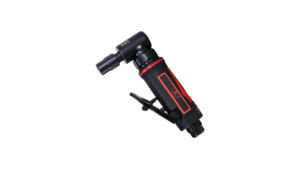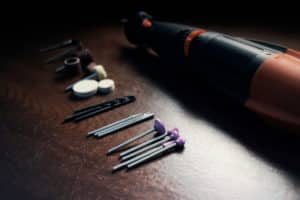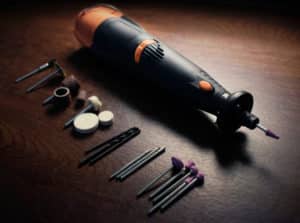
Table of Contents
If you’ve ever wondered about the differences and similarities between die grinders and cut-off tools, you’re not alone. Understanding their distinctions is crucial for selecting the right tool for your projects. Both are power tools, but they serve distinct purposes in metalworking and fabrication. While die grinders excel at intricate detailing and precision work, cut-off tools are designed for making straight cuts in metal. So, let’s answer the question – is a die grinder the same as a cut-off tool?
Understanding the Tools
Die Grinders Explained
Die grinders are good tools that you can use for various tasks. They are handheld power tools, perfect for grinding, polishing, and shaping materials. These versatile tools can accommodate different attachments to suit your specific needs. For example, you can attach a cutting wheel for metalworking or a rotary burr for shaping wood.
When using a die grinder, it’s essential to wear safety glasses and gloves to keep yourself safe from any debris or sparks that may fly off during operation. Make sure to choose the right attachment and speed setting based on the material you’re working with.
Cut-Off Tools Explained
Cut-off tools are another type of good tool designed specifically for cutting through hard materials like metal or concrete. You’ll find them in both electric and pneumatic versions, giving you options based on your preferences and available power sources.
For instance, if you need portability without being tethered by cords, an electric cut-off tool might be ideal. On the other hand, if you require more power for heavy-duty tasks in a workshop setting, a pneumatic cut-off tool could be the better choice.
When using a cut-off tool, always ensure proper ventilation when working with materials like metal or concrete as they produce dust and fumes that can be harmful if inhaled.
Key Difference
Die grinders primarily focus on grinding and shaping tasks. They are perfect for smoothing out rough edges, removing excess material, or even carving intricate designs into wood or metal surfaces. On the other hand, cut-off tools excel in cutting through tough materials like metal rods, bolts, or concrete blocks. Imagine using a cut-off tool to quickly slice through a thick metal pipe with precision and ease.
Each tool serves a distinct purpose based on its function variation. So when you’re working on a project that requires precise grinding and shaping, you’d reach for a die grinder. But if your task involves heavy-duty cutting applications like slicing through tough metals or concrete, then the cut-off tool is your go-to equipment.
Similarities in Functionality
Common Features
Both die grinders and cut-off tools share some common features that make them versatile and user-friendly. They often come with variable speed settings, allowing you to adjust the tool’s speed based on the task at hand. This versatility is handy when working with different materials or needing precision in your work.
Both tools are designed for comfortable operation, typically featuring ergonomic handles that reduce strain during extended use. Safety is also a priority, as these tools commonly include features like spindle locks and adjustable guards to protect you while using them.
Primary Functions
Understanding the primary functions of each tool can help you decide which one is best suited for your needs. Die grinders are perfect for intricate tasks such as grinding, honing, or engraving due to their high-speed rotation and ability to access tight spaces. On the other hand, cut-off tools excel at making straight, precise cuts in hard materials like metal pipes or rods.
When deciding between a die grinder and a cut-off tool, it’s important to consider what type of work you’ll be doing most frequently. If your projects involve detailed shaping or smoothing surfaces, a die grinder might be the better choice. However, if your focus is on cutting through tough materials with accuracy and efficiency, then a cut-off tool would likely be more suitable for your needs.
Safety Concerns
Cut-Off Wheels Risks
When using a cut-off tool, it’s crucial to avoid using damaged or incorrect cut-off wheels. Doing so can lead to dangerous kickbacks or breakage, posing serious risks of injury. Always ensure that you have the right type and size of wheel for the material being cut. Inadequate safety precautions when using cut-off wheels can result in severe injuries such as cuts or burns. Therefore, it’s essential to be aware of these risks and take appropriate measures to mitigate them.
Die Grinder Precautions
When operating a die grinder, always prioritize your safety by wearing appropriate eye protection. This is important for preventing any debris from entering your eyes while working with the grinder. Moreover, make sure you use the correct attachments and securely mount them before starting any operation with the die grinder. Following this guideline ensures safe usage and minimizes potential accidents that could occur due to loose or improperly attached accessories.
To sum up, whether you are using a cut-off tool or a die grinder, prioritizing safety is paramount. Always be mindful of the potential risks associated with these tools and take necessary precautions to protect yourself from harm while working with them.
Material Compatibility
Die Grinder Uses
They are widely used in various industries such as metalworking, woodworking, and automotive. These versatile tools can handle tasks like deburring, sanding, and polishing. For example, if you’re working on a metal piece that needs smoothing or shaping, a die grinder can be your go-to tool.
Die grinders are mounted with different attachments based on the task at hand. This versatility makes them indispensable across different applications. Imagine having a single tool that can help you polish metal pieces for your DIY project and then assist in shaping wood for another project—that’s the power of a die grinder.
Cut-Off Tool Capabilities
Now let’s talk about cut-off tools. These tools excel at making swift cuts through tough materials like metal sheets, bolts, or thick pipes. Their ability to create clean and precise cuts is especially valuable in fabrication and construction work where accuracy is crucial.
If you need to trim down a piece of metal or cut through some heavy-duty material quickly and precisely—this is where a cut-off tool shines! Whether you’re working on plumbing repairs or crafting metal sculptures, having a reliable cut-off tool by your side ensures that you can make accurate cuts effortlessly.
Application Comparison
When to Use Die Grinders
If you’re working on intricate detailing, shaping, or smoothing metal surfaces during fabrication work, die grinders are your go-to tools. They excel in achieving fine finishes on materials like steel or aluminum when precision and control are paramount. For example, let’s say you’re crafting a custom metal art piece with delicate patterns and curves. In this case, using a die grinder allows you to meticulously shape the metal according to your design.
When experience is required for specialized applications, knowing when to use die grinders ensures optimal results. Whether it’s creating precise grooves in metal pipes or sculpting metal sculptures with intricate details, die grinders offer the finesse needed for such tasks.
When to Use Cut-Off Tools
Cut-off tools come into play when you need to make straight cuts through tough materials like steel bars or concrete blocks. Their efficiency shines through in tasks requiring swift material removal or precise sectioning. For instance, if you’re working on a project that involves cutting thick steel rods into specific lengths for construction purposes, using a cut-off tool streamlines the process significantly.
Identifying the appropriate scenarios for using cut-off tools enhances productivity in challenging cutting projects where tough materials need quick and precise sectioning without compromising accuracy.
Cost Considerations
Die Grinder Pricing
There’s a wide range to consider. Entry-level die grinders are perfect for hobbyists or occasional users who want an affordable option. On the other hand, high-end die grinders with advanced features may come at a premium price point, more suited for professional use. By understanding the pricing range, you can select a die grinder that aligns with your budget and requirements.
For example, if you’re someone who enjoys DIY projects and only plans to use the tool occasionally, an entry-level die grinder might be the ideal choice. However, if you’re a professional in need of a powerful and durable tool for regular use, investing in a high-end die grinder could be more beneficial in the long run.
Cut-Off Tool Expenses
Cut-off tools also vary in price based on several factors such as power source, cutting capacity, and additional features like adjustable guards or blade types. If you’re a DIY enthusiast looking for budget-friendly options without compromising quality, there are plenty available. Conversely, industrial-grade cut-off tools cater to heavy-duty applications at higher costs.
Making the Right Choice
Assessing Needs
When deciding between a die grinder and a cut-off tool, it’s crucial to consider your specific tasks. Think about the materials you frequently work with and the conditions of your workspace. For instance, if you often handle metal or need precise detailing, a die grinder might be more suitable. On the other hand, if you primarily focus on cutting through tough materials like metal rods or pipes, a cut-off tool could be your best bet.
Conducting a thorough assessment ensures that you invest in the right tool tailored to your needs. By carefully evaluating your requirements and workspace conditions, you can make an informed decision that aligns with your usage scenarios.
Expert Recommendations
Seeking expert insights is an easy way to gain valuable recommendations when choosing between die grinders and cut-off tools. Experts can provide guidance based on their experience with different brands and models. They can advise you on essential features to consider before making a purchase decision.
Final Remarks
You’ve now grasped the ins and outs of die grinders and cut-off tools. Understanding their differences and similarities, considering safety concerns, material compatibility, application comparison, and cost considerations has equipped you to make the right choice for your specific needs. Whether you’re a professional tradesperson or a DIY enthusiast, knowing which tool aligns with your requirements can make a substantial impact on the quality and efficiency of your work.
So, as you embark on your next project, take into account all the factors we’ve discussed. Your choice between a die grinder and a cut-off tool can significantly influence the outcome. Remember to prioritize safety, consider the materials you’ll be working with, and weigh the costs against the functionalities each tool offers. Armed with this knowledge, go forth and tackle your tasks with confidence!
Frequently Asked Questions
Is a die grinder the same as a cut-off tool?
No, they are not the same. A die grinder is primarily used for grinding, while a cut-off tool is designed for cutting. Each tool has specific functions and applications, so it’s important to understand their differences before using them.
Which safety concerns should I consider when using these tools?
Always wear appropriate safety gear such as goggles and gloves. Be mindful of sparks and debris when using both tools. Remember that proper ventilation is crucial due to the dust and particles generated during operations.
What are the key differences between these tools?
The main difference lies in their primary function – one is for grinding (die grinder) while the other is for cutting (cut-off tool). The design of each tool also differs to accommodate their respective purposes.
Are there any similarities in functionality between these tools?
Both tools operate at high speeds and require precision control. They also share similarities in terms of being handheld power tools that can be used with various attachments for different tasks.
How do I determine which tool, blade screwdriver or screwdriver slot, to use based on material compatibility?
Consider the hardness and thickness of the material you’re working with. For softer materials like plastic or wood, a die grinder may be more suitable; whereas, for metal or harder materials, a cut-off tool would be more effective.



